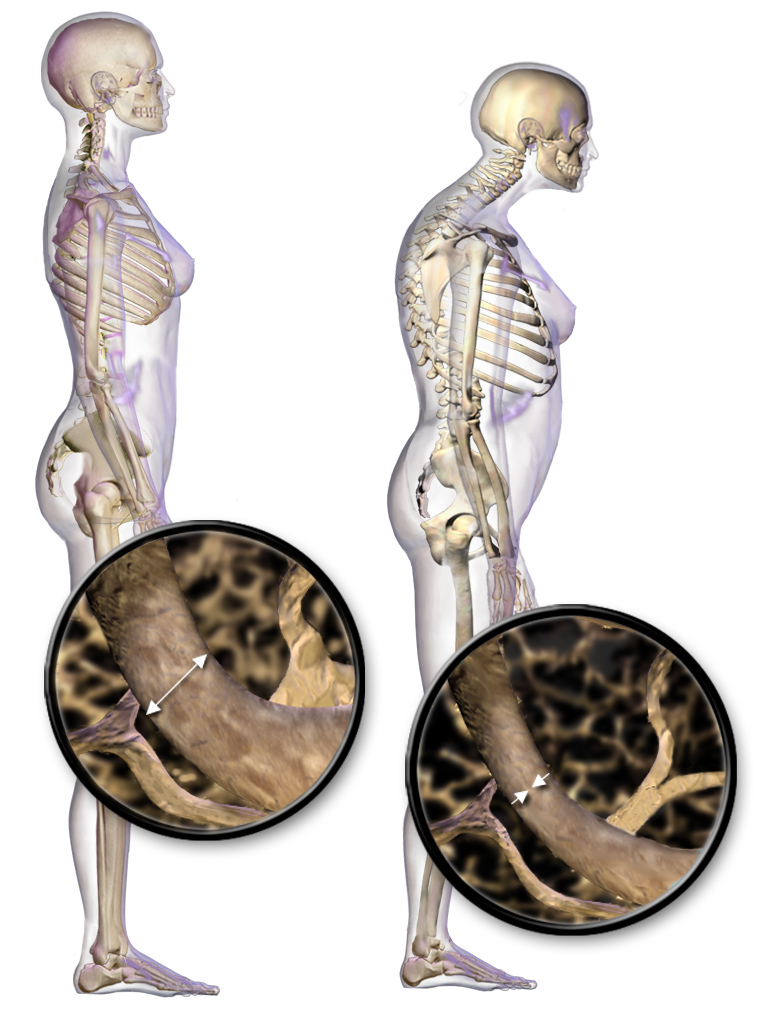|
Bisphosphonate
Bisphosphonates are a class of drugs that prevent the loss of bone density, used to treat osteoporosis and similar diseases. They are the most commonly prescribed to treat osteoporosis. Evidence shows that they reduce the risk of fracture in post-menopausal women with osteoporosis. Bone tissue undergoes constant remodeling and is kept in balance (homeostasis) by osteoblasts creating bone and osteoclasts destroying bone. Bisphosphonates inhibit the digestion of bone by encouraging osteoclasts to undergo apoptosis, or cell death, thereby slowing bone loss. The uses of bisphosphonates include the prevention and treatment of osteoporosis, Paget's disease of bone, bone metastasis (with or without hypercalcemia), multiple myeloma, primary hyperparathyroidism, osteogenesis imperfecta, fibrous dysplasia, and other conditions that exhibit bone fragility. Chemical structure and mechanistic aspects The term bisphosphonate refers to the presence two phosphonate () groups. The ... [...More Info...] [...Related Items...] OR: [Wikipedia] [Google] [Baidu] |
Osteogenesis Imperfecta
Osteogenesis imperfecta (; OI), colloquially known as brittle bone disease, is a group of genetic disorders that all result in bones that bone fracture, break easily. The range of symptoms—on the skeleton as well as on the body's other Organ (biology), organs—may be mild to severe. Symptoms found in various types of OI include sclera, whites of the eye (sclerae) that are blue instead, short stature, joint hypermobility, loose joints, hearing loss, breathing problems and problems with the teeth (dentinogenesis imperfecta). Potentially life-threatening Complication (medicine), complications, all of which become more common in more severe OI, include: tearing (Dissection (medical), dissection) of the major arteries, such as Aortic dissection, the aorta; pulmonary insufficiency, pulmonary valve insufficiency secondary to distortion of the ribcage; and basilar invagination. The underlying mechanism is usually a problem with connective tissue due to a lack of, or poorly forme ... [...More Info...] [...Related Items...] OR: [Wikipedia] [Google] [Baidu] |
Alendronate
Alendronic acid, sold under the brand name Fosamax among others, is a bisphosphonate medication used to treat osteoporosis and Paget's disease of bone. It is taken by mouth. Use is often recommended together with vitamin D, calcium supplementation, and lifestyle changes. Common side effects (1 to 10% of patients) include constipation, abdominal pain, nausea, and acid reflux. Use is not recommended during pregnancy or in those with poor kidney function. Alendronic acid works by decreasing the activity of cells that break down bone. Alendronic acid was first described in 1978 and approved for medical use in the United States in 1995. It is available as a generic medication. In 2022, it was the 103rd most commonly prescribed medication in the United States, with more than 6million prescriptions. Medical uses Alendronic acid is indicated for the treatment and prevention of osteoporosis in postmenopausal women; the treatment to increase bone mass in men with osteoporosis; the ... [...More Info...] [...Related Items...] OR: [Wikipedia] [Google] [Baidu] |
Osteoporosis
Osteoporosis is a systemic skeletal disorder characterized by low bone mass, micro-architectural deterioration of bone tissue leading to more porous bone, and consequent increase in Bone fracture, fracture risk. It is the most common reason for a broken bone among the Old age, elderly. Bones that commonly break include the vertebrae in the Vertebral column, spine, the bones of the forearm, the wrist, and the hip. Until a broken bone occurs there are typically no symptoms. Bones may weaken to such a degree that a break may occur with minor stress or spontaneously. After the broken bone heals, some people may have chronic pain and a decreased ability to carry out normal activities. Osteoporosis may be due to lower-than-normal peak bone mass, maximum bone mass and greater-than-normal bone loss. Bone loss increases after menopause in women due to lower levels of estrogen, and after andropause in older men due to lower levels of testosterone. Osteoporosis may also occur due to a ... [...More Info...] [...Related Items...] OR: [Wikipedia] [Google] [Baidu] |
Osteitis Deformans
Paget's disease of bone (commonly known as Paget's disease or, historically, osteitis deformans) is a condition involving Bone remodeling, cellular remodeling and deformity of one or more bones. The affected bones show signs of dysregulated bone remodeling at the microscopic level, specifically excessive Osteoclast, bone breakdown and subsequent disorganized new bone formation. These structural changes cause the bone to weaken, which may result in deformity, pain, bone fractures, fracture or arthritis of associated joints. The exact cause is unknown, although leading theories indicate both genetic and acquired factors (see #Causes, Causes). Paget's disease may affect any one or several bones of the body (most commonly pelvis, tibia, femur, lumbar vertebrae, and skull), but never the entire skeleton, and does not spread from bone to bone. Rarely, a bone affected by Paget's disease can transform into a Osteosarcoma, malignant bone cancer. As the disease often affects people diffe ... [...More Info...] [...Related Items...] OR: [Wikipedia] [Google] [Baidu] |
Hypercalcemia
Hypercalcemia, also spelled hypercalcaemia, is a high calcium (Ca2+) level in the blood serum. The normal range for total calcium is 2.1–2.6 mmol/L (8.8–10.7 mg/dL, 4.3–5.2 mEq/L), with levels greater than 2.6 mmol/L defined as hypercalcemia. Those with a mild increase that has developed slowly typically have no symptoms. In those with greater levels or rapid onset, symptoms may include abdominal pain, bone pain, confusion, depression, weakness, kidney stones or an abnormal heart rhythm including cardiac arrest. Most outpatient cases are due to primary hyperparathyroidism and inpatient cases due to cancer. Other causes of hypercalcemia include sarcoidosis, tuberculosis, Paget disease, multiple endocrine neoplasia (MEN), vitamin D toxicity, familial hypocalciuric hypercalcaemia and certain medications such as lithium and hydrochlorothiazide. Diagnosis should generally include either a corrected calcium or ionized calcium level and be confirmed aft ... [...More Info...] [...Related Items...] OR: [Wikipedia] [Google] [Baidu] |
Bone Metastasis
Bone metastasis, or osseous metastatic disease, is a category of cancer metastases that result from primary tumor invasions into bones. Bone-originating primary tumors such as osteosarcoma, chondrosarcoma, and Ewing sarcoma are rare; the most common bone tumor is a metastasis. Bone metastases can be classified as Osteolytic lesion, osteolytic, osteoblastic, or both. Unlike Hematological malignancy, hematologic malignancies which originate in the blood and form non-solid tumors, bone metastases generally arise from epithelium, epithelial tumors and form a solid mass inside the bone. Primary breast cancer patients are particularly vulnerable to develop bone metastases. Bone metastases, especially in a state of advanced disease, can cause severe pain, characterized by a dull, constant ache with periodic spikes of incident pain. Types of lesions Under normal conditions, bone undergoes continuous remodeling through osteoclast-mediated bone resorption and osteoblast-mediated bone depos ... [...More Info...] [...Related Items...] OR: [Wikipedia] [Google] [Baidu] |
Risedronate
Risedronic acid, often used as its sodium salt risedronate sodium, is a bisphosphonate. It slows down the cells which break down bone. It's used to treat or prevent osteoporosis, and treat Paget's disease of bone. It is taken by mouth. It was patented in 1984 and approved for medical use in 1998. Pharmacology History Risedronate, known as NE-58095 while under development, was discovered by scientists at the Cincinnati Miami Valley Laboratories and the Norwich Eaton Laboratories of Procter and Gamble. Society and culture Brand names It is produced and marketed by Warner Chilcott, Sanofi-Aventis, and in Japan by Takeda under the trade names Actonel, Atelvia, and Benet. It is also available in a preparation that includes a calcium carbonate supplement, as Actonel with Calcium. Controversies In January 2006 P&G and its marketing partner Sanofi-Aventis filed a Lanham Act false claims lawsuit against rival drugmakers Roche and GlaxoSmithKline claiming false advertising a ... [...More Info...] [...Related Items...] OR: [Wikipedia] [Google] [Baidu] |
Phosphonate
In organic chemistry, phosphonates or phosphonic acids are organophosphorus compounds containing Functional group, groups, where R is an organic group (alkyl, aryl). If R is hydrogen then the compound is a Phosphite_ester#Chemistry_of_HP(O)(OR)2, dialkyl phosphite, which is a different functional group. Phosphonic acids, typically handled as salts, are generally Volatility (chemistry), nonvolatile solids that are poorly soluble in organic solvents, but soluble in water and common Alcohol (chemistry), alcohols. Many commercially important compounds are phosphonates, including glyphosate (the active molecule of the herbicide Roundup (herbicide), Roundup), and ethephon, a widely used plant growth regulator. Bisphosphonates are popular drugs for treatment of osteoporosis.Svara, J.; Weferling, N.; Hofmann, T. "Phosphorus Compounds, Organic," in ''Ullmann's Encyclopedia of Industrial Chemistry'', Wiley-VCH, Weinheim, 2008. . In biochemistry and medicinal chemistry, phosphonate gr ... [...More Info...] [...Related Items...] OR: [Wikipedia] [Google] [Baidu] |
Multiple Myeloma
Multiple myeloma (MM), also known as plasma cell myeloma and simply myeloma, is a cancer of plasma cells, a type of white blood cell that normally produces antibody, antibodies. Often, no symptoms are noticed initially. As it progresses, bone pain, anemia, Kidney failure, renal insufficiency, and infections may occur. Complications may include hypercalcemia and amyloidosis. The cause of multiple myeloma is unknown. Risk factors include obesity, radiation exposure, family history, age and certain chemicals. There is an increased risk of multiple myeloma in certain occupations. This is due to the occupational exposure to aromatic hydrocarbon solvents having a role in causation of multiple myeloma. Multiple myeloma is the result of a multi-step malignant transformation, and almost universally originates from the pre-malignant stage monoclonal gammopathy of undetermined significance (MGUS). As MGUS evolves into MM, another pre-stage of the disease is reached, known as Smouldering ... [...More Info...] [...Related Items...] OR: [Wikipedia] [Google] [Baidu] |
Pamidronate
Pamidronic acid or pamidronate disodium or APD (marketed as Aredia among others), is a nitrogen-containing bisphosphonate used to prevent osteoporosis. It was patented in 1971 and approved for medical use in 1987. Medical uses It is used to prevent bone loss, and treat osteoporosis. It is also used to strengthen bone in Paget's disease, to prevent bone loss due to steroid use, and in certain cancers with high propensity to bone, such as multiple myeloma. Due to its ability to sequester calcium in bone, it is also used to treat high calcium levels. It is also used as an experimental treatment of the bone disorder osteogenesis imperfecta. It has been studied in the treatment of complex regional pain syndrome. Administration Intravenous, usually 90 mg monthly. 30 mg, 60 mg, 90 mg and for hospitals, 120 mg vials are available, mixed with mannitol. Side effects Common side effects include bone pain, low calcium levels, nausea, and dizziness. Osteone ... [...More Info...] [...Related Items...] OR: [Wikipedia] [Google] [Baidu] |
Osteoclasts
An osteoclast () is a type of bone cell that breaks down bone tissue. This function is critical in the maintenance, repair, and remodeling of bones of the vertebral skeleton. The osteoclast disassembles and digests the composite of hydrated protein and mineral at a molecular level by secreting acid and a collagenase, a process known as '' bone resorption''. This process also helps regulate the level of blood calcium. Osteoclasts are found on those surfaces of bone that are undergoing resorption. On such surfaces, the osteoclasts are seen to be located in shallow depressions called ''resorption bays (Howship's lacunae)''. The resorption bays are created by the erosive action of osteoclasts on the underlying bone. The border of the lower part of an osteoclast exhibits finger-like processes due to the presence of deep infoldings of the cell membrane; this border is called ''ruffled border''. The ruffled border lies in contact with the bone surface within a resorption bay. The ... [...More Info...] [...Related Items...] OR: [Wikipedia] [Google] [Baidu] |






